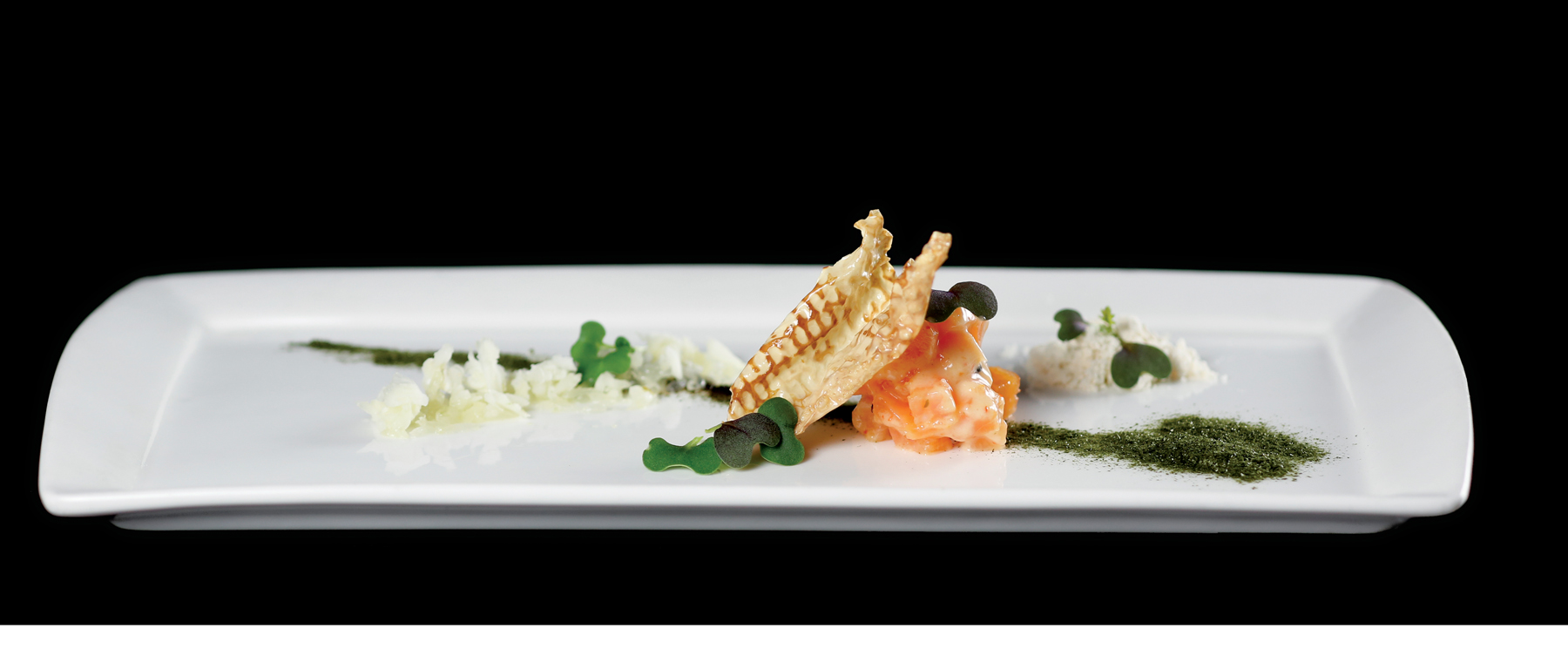NITRO SUSHI
Serves 6
This is a clean, simple dish combining elements of Japanese sushi. Salmon is diced and mixed with togarashi aioli. We freeze limes in liquid nitrogen to release each individual vesicle. The dish is topped with sesame oil powder and fried yuba—the delicate skin that forms when soy milk is heated. Sushi nori is ground in a spice grinder and adds ocean flavor. The dish has crunchy, sour, salty, and mineral elements that fill your mouth with flavor while still adhering to the Japanese ideal of clean simplicity and perfect ingredients.
TOGARASHI AIOLI:
20 grams (about 1 large) egg yolk
10 grams fresh lime juice
1 gram salt
3 grams shichimi togarashi
Grated zest of 1 lime
150 grams canola oil
SALMON TARTARE:
300 grams sushi-grade salmon fillet
1.5 grams salt
30 grams Togarashi Aioli
LIME VESICLES:
3 limes, cut into 6 wedges each
SOY MILK:
100 grams shelled soybeans
500 grams water
3 grams salt
YUBA:
Reserved soy milk
Canola oil for frying
SESAME OIL POWDER:
100 grams tapioca maltodextrin (see Sources, here)
1 gram salt
100 grams sesame oil
TO FINISH:
50 grams nori, ground to a powder in a spice grinder
Micro shiso
SPECIAL EQUIPMENT:
Liquid nitrogen (see Sources, here; optional)
Insulated container or dewar (optional)
Dehydrator (optional)
TOGARASHI AIOLI:
Put the egg yolk, lime juice, salt, shichimi togarashi, and lime zest in a food processor. Turn the machine on and while it is running, slowly drizzle in the oil. When the mixture becomes thick and creamy and all the oil has been absorbed, stop the food processor and transfer the Togarashi Aioli to a covered container and refrigerate until needed, up to 3 days.
SALMON TARTARE:
Dice the salmon fillet into ¼-inch cubes. Put the salmon in a mixing bowl with the salt and mix gently to season the fish. Add 30 grams of the Togarashi Aioli and mix gently to blend. Transfer to a small container and press a piece of plastic wrap against the surface of the fish. Refrigerate until ready to serve, up to 3 hours.
LIME VESICLES:
Fill a dewar or insulated container with liquid nitrogen. Use a spider to put the lime segments in the nitrogen and wait until the nitrogen stops bubbling, when the limes will be completely frozen, to remove them. Transfer the frozen lime segments to a mixing bowl. Invert another bowl on top of the mixing bowl to create a closed sphere. Shake the mixing bowl to break open the lime segments and separate the vesicles from the skins. Scoop out the lime flesh, discarding the skins and debris, and store in a covered container in the freezer until ready to serve.
Alternatively, you can use a paring knife to cut open the skins and peel the lime segments as best you can. Lay the segments out on a sheet pan and freeze them for at least 6 hours or until frozen solid. Put the frozen lime segments in a heavy-duty zipper-lock bag and lay it on
a cutting board. Use a rolling pin to smash the segments, breaking the lime vesicles apart. Gently remove and discard any remaining skin or fibers and store the lime vesicles in a covered container in the freezer until ready to serve.
SOY MILK:
Put the soybeans and water in a lidded container to soak overnight, at least 8 hours and up to 24 hours. The next day, put the beans, water, and salt in a blender. Puree for 1 to 2 minutes, until smooth. Line a fine-mesh sieve with damp cheesecloth and strain the soy milk into a saucepot. Twist and squeeze the cheesecloth the get all of the soy milk from the beans.
Set the saucepot over medium heat and bring to a simmer. Simmer for 15 minutes, stirring occasionally. Use immediately or let cool, stirring occasionally to avoid forming a skin, and reserve in a covered container in the refrigerator until ready to make Yuba.
YUBA:
Pour the Soy Milk into a large sauté pan and set over low heat. Allow a skin to form on top of the soy milk. Use a chopstick to release the edges of the milk skin, then lift it up and transfer it to a dehydrator rack or a wire rack set over a sheet pan. Dehydrate for 4 hours at 90°F or in your oven at the lowest setting until completely dry. Break the dried yuba skin into 6 pieces for frying.
Preheat a deep fat fryer or pot of oil on the stove to 400°F.
Line a sheet pan with paper towels. Fry the yuba skins for 30 seconds and then transfer to the prepared sheet pan to cool.
SESAME OIL POWDER:
Put the tapioca maltodextrin and salt in a food processor. Turn on the food processor and slowly drizzle in the sesame oil. Scrape down the sides of the food processor and continue to process until the oil is completely absorbed. Transfer the Sesame Oil Powder to an airtight container until ready to serve. Just before plating, transfer the powder to a small tea strainer and dip it in a pot filled with liquid nitrogen to freeze the powder. Alternatively, spread across a sheet pan and freeze for several hours.
TO FINISH:
Place 30 grams of Salmon Tartare on each of 6 plates. Top with 1 fried Yuba skin. Spoon 10 grams of frozen Lime Vesicles onto the plate. Dust the plate with nori powder. Use a tea strainer to strain out a scoop of Sesame Oil Powder and dust it over the top of the salmon. Garnish with a few micro shiso leaves. Repeat with the 5 remaining plates, and serve immediately.
